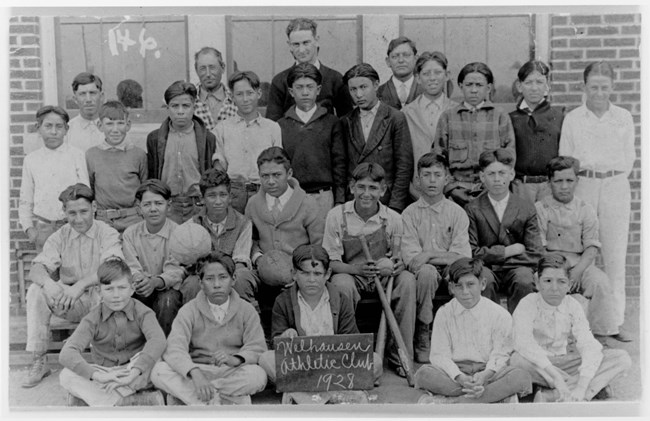Last updated: December 18, 2023
Article
Lyndon B. Johnson The Teacher
In 1924, 15-year-old Lyndon Johnson graduated from the Johnson City High School in Texas. His college-educated parents, not surprisingly, wanted their eldest child to go to college as well. Lyndon, being 15 and acting like every 15-year-old boy in history, did not want to do what his parents wanted him to do. He wanted to make his own mark on the world. In this spirit, he and some buddies took off for parts unknown and ended up in California to earn their riches. Lyndon took whatever job he could find, ranging from working in a diner, to his cousin’s law office, to road construction. Three years later, he returned home, no richer, but much wearier.
It was then that Lyndon set his sights on higher education, a pivot which very much pleased his mother, Rebekah, who made it her mission to help her oldest son succeed. She coached him for his entrance exams for Southwest Texas State Teachers College (now Texas State University) in San Marcos, about 30 miles from Johnson City, and, with her help, he passed. Thus began his period of remarkable growth.
In San Marcos, young Lyndon perfected a pattern that would later catalyze his rise to political power: he developed a personal and professional relationship with the nexus of power. In this case, that person was the president of the college, Dr. Cecil Evans. Lyndon landed a job working for Dr. Evans as assistant to his personal secretary. This position gave him a unique vantage point from which to observe the inner workings of the college and its surrounding politics. From there, Lyndon grew to understand the politics of organizational management and the impact of strong leadership.

Photo courtesy of LBJ Library
In 1928, as a college sophomore, he needed to earn money to continue his education. Evans secured him a teaching job at the Welhausen Ward Elementary School in the segregated border town of Cotulla, Texas. The school served impoverished Mexican-American students, who, by Lyndon’s recollection, often came to school hungry. He cared deeply for his students in Cotulla and felt that their success was hindered only by their circumstance, not the substance of their character.
Within three months, Lyndon developed a myriad of uplifting programs at the Cotulla school. There were an array of contests, including spelling and public speaking, as well as the introduction of organized sports. Lyndon used money from his first paycheck to purchase softball bats and gloves, volleyballs, and basketballs for the school. He coached several sports and activities including debate, softball, and volleyball, and he invited parent involvement in extracurricular activities. Knowing students are not able to study when hungry, he established a food program to ensure the kids received at least one meal a day.
Lyndon Johnson’s nine months in Cotulla showed him the impact of racial and social inequity and gave him a sense of purpose. It also provided him the opportunity to directly impact an unfair system.
When he returned to San Marcos to finish his college studies, Lyndon seriously considered dedicating his life to teaching. He later told author Doris Kearns: “I thought originally I’d be a teacher, but […] Dr. Evans told me there wouldn’t be enough competition in the classroom to satisfy me. He thought I was a competitive animal. My ambition, he said, was laudable—to be either a teacher or a preacher or a politician. Teachers can see the fruits of their work in the performance of their students, preachers in the morality of their parishioners, and public servants in the people’s progress. But he thought that being a public servant would be best because I’d have to meet the challenges of the time at the very moment they were happening”.
As we know, Lyndon Johnson chose to follow the call to a life in politics, but he remained dedicated to the idea of education as a pathway for individual and societal betterment, as is reflected in his passage of several pieces of education-related legislation. Over one thousand pieces of legislation were enacted during his presidency, ranging from civil rights to health care to labor laws, each one dedicated to improving people’s lives. The one President Johnson was most proud of was the Elementary and Secondary School Act of 1965, a precursor to today’s No Child Left Behind Act that provided federal funding for programs, supplies, and professional development. But perhaps most importantly, it provided access to education to whomever wanted it, no matter their economic background. This act was over 40 years in the making, a direct result of what Lyndon Johnson had experienced years before in Cotulla.
Lyndon Johnson loved being a teacher, and he learned a great deal from his young students in Cotulla, Texas. Giving students like them the path to education was his way of giving back.
